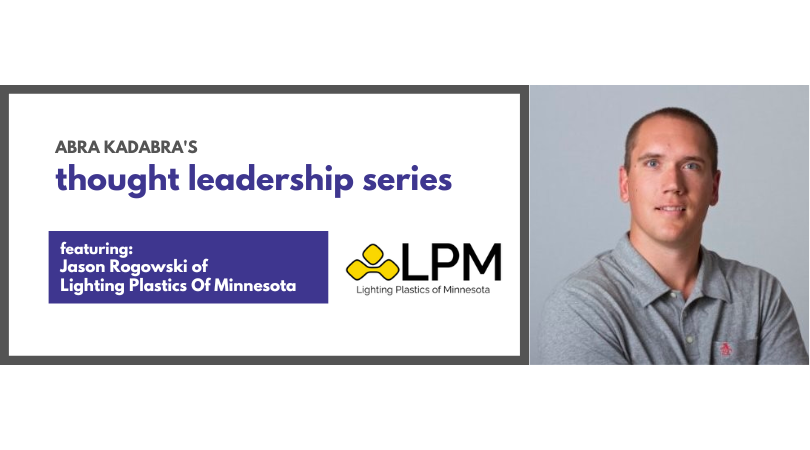Jason Rogowski has always been passionate about numbers.
Early on, he realized he had a natural aptitude for math and his parents and teachers encouraged him to continue down that path as far as it could take him. And it ended up taking him pretty far!
After earning a Master’s degree in biostatistics from the University of Minnesota, Rogowski began his career doing data analysis on clinical trials for medical devices. He then pivoted into business analytics, drawn in by the faster pace of the work.
“Plus, there was more ability to experiment without human lives at risk,” he said with a laugh.
Rogowski went on to spend seven years working at Polaris. He started out in the web and marketing analytics space and eventually moved into general data science, analytics and predictive modeling. Under his leadership, his team grew and expanded into the manufacturing side of the business. And that’s when he, along with two of his longtime work partners, began exploring the idea of going into manufacturing on their own.
That said, Rogowski knew he didn’t want to start a company from scratch.
“None of us were comfortable leaving a relatively stable corporate job and paycheck and making a leap into the unknown,” he said. “We knew we wanted something that already had some kind of established revenue stream.”
With that idea in mind, Rogowski and his partners began looking for Twin Cities-based manufacturing companies that were for sale. After more than a year of searching and evaluating their options, the three men purchased St. Louis Park-based Lighting Plastics of Minnesota, a 40-year old company that manufactures and distributes lighting products and solutions.
“We got pretty serious about two or three businesses,” Rogowski said. “But ultimately, the size of this one, the geographic location and the diversity of customers – those were very central factors in us selecting Lighting Plastics. Also, with the company being 40 years old and having relatively stable financials, the risk was – at least in our estimation – a lot less than going into one of our garages and trying to invent something.”
Now, with a year of ownership under his belt, Rogowski has not only learned a lot about the lighting industry, he’s also gotten a crash course in running a business. And one of his main takeaways is that you have to be patient and give the seeds you plant time to blossom.
“We bought a business that was basically stagnant for several years with the intent to grow it, but growing anything takes a lot of time, money and energy,” Rogowski said. “We’ve had some decent successes and some complete failures and I just chalk it up to learning as we go. Now we’re finally starting to gather momentum and seeing the little things we’ve done begin to pay off.”
If you’ve been considering purchasing an existing business and you want to hit the ground running, here are a few of Rogowski’s tips and suggestions:
- Take your time: Just like finding a new home, choosing the right business to purchase takes time. And if you put a hard-and-fast deadline on yourself, you could end up ignoring obvious red flags and making a poor decision. Rogowski also suggests removing the emotional element from your search as best you can, though that’s sometimes easier said than done. Essentially, remember that buying a business that’s not the right fit can be a costly mistake so give yourself as much time as possible – and listen to your gut – before pulling the trigger.
- Do your financial due diligence: It’s not enough to just look at the bottom line and make assumptions that everything you see is correct. “You have to understand the story behind the numbers before you can really be sure what you’re buying,” Rogowski said. “That’s probably the hardest part, but it’s absolutely critical.” Take a look at the business’s expenses and really drill down on what they are. Is there a way you can reduce them? Also, consider the work that the current owner does for the company. Will you be able to replicate it with your own skills or will you have to hire it out? These are important things to consider before signing on the dotted line.
- Manage your expectations: Taking over an existing company has certain advantages, but it also comes with challenges. That’s why you have to keep your expectations in check and understand that change doesn’t always happen as fast as you want it to. “Just redoing your website and expecting your online sales to double isn’t realistic,” Rogowski said. “It takes time and you have to be persistent, especially with your marketing and growth activity. You have to put yourself out there over and over to stay top of mind.” Additionally, building relationships with your company’s existing roster of customers isn’t going to happen overnight, even if you get a warm handoff from the previous owner – which is never guaranteed. “We inherited more than 1,000 different customers and it has taken time to get to know them,” he said. “We’re still working on that now, but finally after a year, I think we’ve met or talked to most of our key customers.”
- Implement change gradually: When Rogowski took ownership of Lighting Plastics, much of the work was being done manually. He’s since done a major overhaul of their operating procedures, implementing a digital tracking system that has helped them stay on top of their quotes, orders, shipments, backlogs and payments. However, Rogowski and his partners didn’t simply walk in on day one and start barking orders or issuing mandates. Instead, they tapped into the knowledge of the company’s current employees to get input and direction on what changes should be made. “It’s been more of a co-op and an ‘all hands on deck’ exercise, which not only gave us a clearer picture of what was going to actually be valuable and streamline the business, but also helped us with better adoption from our employees,” he said.
- Keep the lines of communication open with your team: One of the first things Rogowski did when he took over the reins at Lighting Plastics was to create an organizational chart that clarified who reports to whom. He’s also encouraging an open flow of dialog where employees meet regularly with their supervisors to share what’s going well along with any concerns they might have. Additionally, he and his partners are committed to being transparent with everyone on the team. During quarterly meetings, they gather to talk about the company’s high-level, long-term growth strategies, which in turn helps make the short-term decisions that are being made make more sense. “In general, it’s worked pretty well,” he said. “We’ve retained all but one of our existing employees and they’re still here a year later.”
Abra Kadabra Environmental Services is proud to share the wisdom of business owners from our community through our thought leadership series. If you’d like to be featured, click here.







